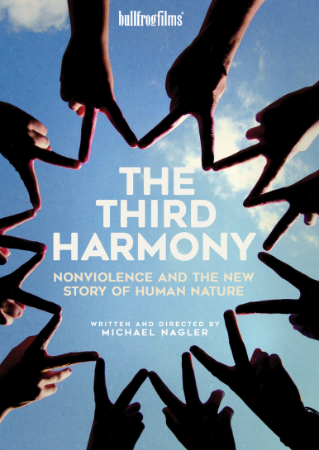
The Third Harmony 2020
Distributed by Bullfrog Films, PO Box 149, Oley, PA 19547; 800-543-FROG (3764)
Produced by Tom Eddington and Steve Michelson
Directed by Michael Nagler, Ph.D.
Streaming, 44 mins
High School - General Adult
Activism; Interpersonal Communication; Protest Movement
Date Entered: 12/07/2020
Reviewed by Brandon West, Social Sciences Librarian, State University of New York at GeneseoDirector Nagler uses his expertise as a respected nonviolence scholar to craft a film that serves as an introduction to nonviolence as a tool of resistance. The power behind this concept lies within its name–simply put, choosing nonviolence is to choose peaceful ways of resolving conflict that arises in political and social contexts. This instructional film provides a basic overview of nonviolence and explores how it has been utilized for decades and across many cultures and societies facing unrest. For these reasons, the film is very timely–the content of the film can help individuals better understand current social unrest being demonstrated across the United States through social movements like Black Lives Matter.
The messages presented throughout the film are simple and powerful. For example, one of the core principles of nonviolence is to have unwavering faith in the goodness of people. Nonviolence also requires a great deal of introspection and only works as an individual learns how to deal with their own anger and fear before dealing with others. The film is organized around three questions, which are answered through narration and interviews with other prevalent scholars and activists. The three main questions explored in the film include “What is nonviolence?”; “How does nonviolence work?”; and “What can I do?” This structure helps to scaffold the concept of nonviolence, making it easy to understand as a viewer new to the topic. Even though the premise of nonviolence is simple, it is clear from watching the film that it has many layers begging for further investigation.
At a runtime of 44 minutes, there is a lot of content squeezed into this film, but it never comes across as overwhelming. In some respects, it could be considered too introductory for audiences with some knowledge about nonviolence. The film's exploration of historical events is also a bit sparse as they are used to illustrate points, but not closely examined. This could be viewed as an oversimplification of the effort put into the activists’ nonviolent efforts; however, it is clear that this film is meant to be an entry point into the conversation about nonviolence. The film has a lot of potential for use in the classroom, as the concepts can be applied through personal reflection or examination of social issues. High school or college programs that discuss social justice, protests, interpersonal communication, and/or philosophy would be target audiences for this film. Overall, the film’s message is meaningful in the current socio-political environment and can start a conversation. For these reasons, the film is recommended for library collections.
Published and licensed under the Creative Commons Attribution 4.0 license. Anyone can use these reviews, so long as they comply with the terms of the license.